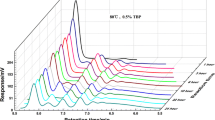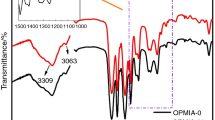Abstract
Toluene diisocyanate (TDI)-based polyisocyanate prepolymer was prepared via TDI self-polymerization with different catalysts at various temperatures. The self-polymerization process was followed by gel permeation chromatography to investigate the formation of individual components. The contents of isocyanate group (–NCO) and free TDI monomer were monitored to confirm the transformation of individual components through back-titration and gas chromatography, respectively. A step-growth polymerization mechanism for TDI-based polyisocyanate reaction was proposed. Simultaneously, a mathematical model was established to simulate the contents of all components in the self-polymerization process, and the simulated data were in good agreement with the experimental results. Mass spectrometry, Fourier transform infrared spectroscopy and 13C nuclear magnetic resonance spectroscopy were employed to identify and confirm the chemical structures of the polyisocyanate prepolymer. The experimental results indicate that several oligomers containing trimer, pentamer, heptamer and higher-molecular-weight oligomers presented simultaneously and interacted with each other. The desired content of each component in TDI-based polyisocyanate prepolymer could be obtained by controlling the reaction conditions.













Similar content being viewed by others
References
Ma W, Wu L, Yang F, Wang S (2014) Non-covalently modified reduced graphene oxide/polyurethane nanocomposites with good mechanical and thermal properties. J Mater Sci 49:562–571. doi:10.1007/s10853-013-7736-4
Chattopadhyay DK, Webster DC (2009) Thermal stability and flame retardancy of polyurethanes. Prog Polym Sci 34:1068–1133
Chattopadhyay DK, Raju K (2007) Structural engineering of polyurethane coatings for high performance applications. Prog Polym Sci 32:352–418
Melchiors M, Sonntag M, Kobusch C, Jürgens E (2000) Recent developments in aqueous two-component polyurethane (2K-PUR) coatings. Prog Org Coat 40:99–109
Osman MA, Mittal V, Morbidelli M, Suter UW (2003) Polyurethane adhesive nanocomposites as gas permeation barrier. Macromolecules 36:9851–9858
Li W, Bouzidi L, Narine SS (2008) Current research and development status and prospect of hot-melt adhesives: a review. Ind Eng Chem Res 47:7524–7532
Park SH, Ryu YS, Kim SH (2015) Effect of modified silica nanoparticle on the properties of bio-based polyurethane ultrafine fibers. J Mater Sci 50:1760–1769. doi:10.1007/s10853-014-8739-5
Kim SH, Park HC, Jeong HM, Kim BK (2010) Glass fiber reinforced rigid polyurethane foams. J Mater Sci 45:2675–2680. doi:10.1007/s10853-010-4248-3
Li S, Zeng J, Wu F, Yang Y, Wang Y (2014) Succinic acid-based biodegradable thermoplastic poly (ester urethane) elastomers: effects of segment ratios and lengths on the physical properties. Ind Eng Chem Res 53:1404–1414
Qi HJ, Boyce MC (2005) Stress-strain behavior of thermoplastic polyurethanes. Mech Mater 37:817–839
Hao J, Han M, Yang Y, Shen Y, Qiu L, Meng X, Shen Q, Cao Z (2006) A device-quality thermosetting polyurethane with improved processability and high thermal stability of dipole alignment for electro-optic applications. React Funct Polym 66:832–839
Das S, Banthia AK, Adhikari B (2008) Porous polyurethane urea membranes for pervaporation separation of phenol and chlorophenols from water. Chem Eng J 138:215–223
Pantoja J, Sader LT, Damianovic M, Foresti E, Silva EL (2010) Performance evaluation of packing materials in the removal of hydrogen sulphide in gas-phase biofilters: polyurethane foam, sugarcane bagasse, and coconut fibre. Chem Eng J 158:441–450
Mendoza-Novelo B, Gonzalez-Garcia G, Mata-Mata JL, Castellano CE, Cuellar-Mata P, Avila EE (2013) A biological scaffold filled with silica and simultaneously crosslinked with polyurethane. Mater Lett 106:369–372
Kumar S, Hablot E, Moscoso JLG, Obeid W, Hatcher PG, DuQuette BM, Graiver D, Narayan R, Balan V (2014) Polyurethanes preparation using proteins obtained from microalgae. J Mater Sci 49:7824–7833. doi:10.1007/s10853-014-8493-8
Ni P, Li J, Suo J, Li S (2004) Study on mechanical properties of polyurethane-attapulgite nanocomposites. J Mater Sci 39:4671–4673. doi:10.1023/B:JMSC.0000034168.13622.41
Maji PK, Guchhait PK, Bhowmick AK (2009) Effect of the microstructure of a hyperbranched polymer and nanoclay loading on the morphology and properties of novel polyurethane nanocomposites. Acs Appl Mater Interfaces 1:289–300
Yoonessi M, Peck JA, Bail JL, Rogers RB, Lerch BA, Meador MA (2011) Transparent large-strain thermoplastic polyurethane magnetoactive nanocomposites. Acs Appl Mater Inter 3:2686–2693
Brugsch HG, Elkins HB (1963) Toluene di-isocyanate (TDI) toxicity. New Engl J Med 268:353–357
Peters JM, Murphy RL (1970) Pulmonary toxicity of isocyanates. Ann Intern Med 73:654–655
Barrioni BR, de Carvalho SM, Oréfice RL, de Oliveira AAR, Pereira MDME (2015) Synthesis and characterization of biodegradable polyurethane films based on HDI with hydrolyzable crosslinked bonds and a homogeneous structure for biomedical applications. Mater Sci Eng C 52:22–30
Blomqvist P, McNamee MS, Stec AA, Gylestam D, Karlsson D (2014) Detailed study of distribution patterns of polycyclic aromatic hydrocarbons and isocyanates under different fire conditions. Fire Mater 38:125–144
Wisnewski AV, Hettick JM, Siegel PD (2011) Toluene diisocyanate reactivity with glutathione across a vapor/liquid interface and subsequent transcarbamoylation of human albumin. Chem Res Toxicol 24:1686–1693
Krol P (2007) Synthesis methods, chemical structures and phase structures of linear polyurethanes. Properties and applications of linear polyurethanes in polyurethane elastomers, copolymers and ionomers. Prog Mater Sci 52:915–1015
Lusignan CP, Mourey TH, Wilson JC, Colby RH (1995) Viscoelasticity of randomly branched polymers in the critical percolation class. Phys Rev E 52:6271
Gasilova E, Benyahia L, Durand D, Nicolai T (2002) Influence of entanglements on the viscoelastic relaxation of polyurethane melts and gels. Macromolecules 35:141–150
Heintz AM, Duffy DJ, Hsu SL, Suen W, Chu W, Paul CW (2003) Effects of reaction temperature on the formation of polyurethane prepolymer structures. Macromolecules 36:2695–2704
Zhitinkina AK, Shibanova NA, Tarakanov OG (1985) Kinetics and mechanism of the catalytic cyclotrimerisation and polycyclotrimerisation of isocyanates. Russ Chem Rev 54:1104
Fiorio R, Pistor V, Zattera AJ, Petzhold CL (2014) Polymerization kinetics of polyurethanes containing trisilanol isooctyl polyhedral oligomeric silsesquioxane. J Elastom Plast 46:594–610
Parnell S, Min K, Cakmak M (2003) Kinetic studies of polyurethane polymerization with Raman spectroscopy. Polymer 44:5137–5144
Lee S, Choi JH, Hong I, Lee JW (2015) Curing behavior of polyurethane as a binder for polymer-bonded explosives. J Ind Eng Chem 21:980–985
Vivaldo-Lima E, Luna-Bárcenas G, Flores-Tlacuahuac A, Cruz MA, Manero O (2002) Modeling of nonlinear polyurethane production in batch reactors using a kinetic-probabilistic approach. Ind Eng Chem Res 41:5207–5219
Vinhal JO, Lage MR, Carneiro JWM, Lima CF, Cassella RJ (2015) Modeling, kinetic, and equilibrium characterization of paraquat adsorption onto polyurethane foam using the ion-pairing technique. J Environ Manage 156:200–208
Zhao Y, Gordon MJ, Tekeei A, Hsieh F, Suppes GJ (2013) Modeling reaction kinetics of rigid polyurethane foaming process. J Appl Polym Sci 130:1131–1138
Pavier C, Gandini A (2000) Urethanes and polyurethanes from oxypropylated sugar beet pulp: I. Kinetic study in solution. Eur Polym J 36:1653–1658
Li S, Vatanparast R, Lemmetyinen H (2000) Cross-linking kinetics and swelling behaviour of aliphatic polyurethane. Polymer 41:5571–5576
He Y, Xie D, Zhang X (2014) The structure, microphase-separated morphology, and property of polyurethanes and polyureas. J Mater Sci 49:7339–7352. doi:10.1007/s10853-014-8458-y
Nagy T, Antal B, Czifrák K, Papp I, Karger Kocsis J, Zsuga M, Kéki S (2015) New insight into the kinetics of diisocyanate-alcohol reactions by high-performance liquid chromatography and mass spectrometry. J Appl Polym Sci 132:42127
Bae JY, Chung DJ, An JH, Shin DH (1999) Effect of the structure of chain extenders on the dynamic mechanical behaviour of polyurethane. J Mater Sci 34:2523–2527. doi:10.1023/A:1004680127857
Arnold RG, Nelson JA, Verbanc JJ (1957) Recent advances in isocyanate chemistry. Chem Rev 57:47–76
Bruenner RS, Oberth AE (1966) On the mechanism of metal chelate catalysis in the reaction between alcohols and isocyanates. J Organ Chem 31:887–891
Sardon H, Engler AC, Chan JM, García JM, Coady DJ, Pascual A, Mecerreyes D, Jones GO, Rice JE, Horn HW (2013) Organic acid-catalyzed polyurethane formation via a dual-activated mechanism: unexpected preference of N-activation over O-activation of isocyanates. J Am Chem Soc 135:16235–16241
Paul F, Moulin S, Piechaczyk O, Le Floch P, Osborn JA (2007) Palladium (0)-catalyzed trimerization of arylisocyanates into 1, 3, 5-triarylisocyanurates in the presence of diimines: a nonintuitive mechanism. J Am Chem Soc 129:7294–7304
Caraculacu AA, Coseri S (2001) Isocyanates in polyaddition processes. Structure and reaction mechanisms. Prog Polym Sci 26:799–851
Roman M, Andrioletti B, Lemaire M, Bernard J, Schwartz J, Barbeau P (2011) Investigations providing a plausible mechanism in the hexamethyldisilazane-catalyzed trimerization of alkyl isocyanates. Tetrahedron 67:1506–1510
He Y, Zhang X, Zhang X, Huang H, Chang J, Chen H (2012) Structural investigations of toluene diisocyanate (TDI) and trimethylolpropane (TMP)-based polyurethane prepolymer. J Ind Eng Chem 18:1620–1627
He Y, Zhang X, Zhang X, Huang H, Chang J, Chen H (2013) A recycling model of excess toluene diisocyanate isomers in the preparation of polyurethane prepolymer. J Appl Polym Sci 127:2176–2183
Shibata M, Asahina M, Teramoto N, Yosomiya R (2001) Chemical modification of pullulan by isocyanate compounds. Polymer 42:59–64
Ishihara K, Niwa M, Kosugi Y (2008) Zwitterionic salts as mild organocatalysts for transesterification. Org Lett 10:2187–2190
Parnell S, Min K (2005) Reaction kinetics of thermoplastic polyurethane polymerization in situ with poly (vinyl chloride). Polymer 46:3649–3660
Xie C, Dai Y, Mei H, Han J, Soloshonok VA, Pan Y (2015) Asymmetric synthesis of quaternary α-fluoro-β-keto-amines via detrifluoroacetylative Mannich reactions. Chem Commun
Córdova A (2004) The direct catalytic asymmetric Mannich reaction. Acc Chem Res 37:102–112
Hisayama H, Takase K (1973) 2,2-Bis [3,5-bis [(dimethylamino)methyl]-4-hydroxyphenyl] propane (JP 48000814 B4)
Gupta P, Henes G, Muller HJ, Zirner J (1978) Process for the production of polyisocyanates containing isocyanurate groups (US 4115373A)
Ionescu M, Wan X, Bilić N, Petrović ZS (2012) Polyols and rigid polyurethane foams from cashew nut shell liquid. J Polym Environ 20:647–658
Tramontini M, Angiolini L, Ghedini N (1988) Mannich bases in polymer chemistry. Polymer 29:771–788
Stagg HE (1946) A method for the determination of isocyanates. Analyst 71:557–559
Thomasson D, Boisson F, Girard-Reydet E, Mechin F (2006) Hydroxylated hyperbranched polyesters as crosslinking agents for polyurethane networks: partial modification of the OH chain ends. React Funct Polym 66:1462–1481
Risch N, Westerwelle U, Kiene J, Keuper R (1999) Preparation, characterization and selective reactions of novel [1, 3] diazetidine-2, 4-diones (uretdiones)—a new route to generate asymmetric substituted toluylenediisocyanate-derivatives. Journal für praktische Chemie 341:616–619
Zhao C, Yang PF, Ping Wang S, Li JY, Li TD (2011) Synthesis and characterization of asymmetric substituted dicarbamates. Chin Chem Lett 22:1167–1170
Querat E, Tighzert L, Pascault JP, Dušek K (1996) Blocked isocyanate. Reaction and thermal behaviour of the toluene 2,4-diisocyanate dimer. Die Angewandte Makromolekulare Chemie 242:1–36
Hablot E, Zheng D, Bouquey M, Avérous L (2008) Polyurethanes based on castor oil: kinetics, chemical, mechanical and thermal properties. Macromol Mater Eng 293:922–929
Catrouillet S, Fonteneau C, Bouteiller L, Delorme N, Nicol E, Nicolai T, Pensec S, Colombani O (2013) Competition between steric hindrance and hydrogen bonding in the formation of supramolecular bottle brush polymers. Macromolecules 46:7911–7919
Labet M, Thielemans W, Dufresne A (2007) Polymer grafting onto starch nanocrystals. Biomacromolecules 8:2916–2927
Semsarzadeh MA, Navarchian AH (2003) Effects of NCO/OH ratio and catalyst concentration on structure, thermal stability, and crosslink density of poly(urethane-isocyanurate). J Appl Polym Sci 90:963–972
Jin C, Lu J, Li WS, Zhou L, Huang QM, Yang XH (2006) Synthesis and characterization of butan-1-ol modified toluene diisocyanate trimer. J Appl Polym Sci 102:4958–4962
Ni H, Aaserud DJ, Simonsick WJ Jr, Soucek MD (2000) Preparation and characterization of alkoxysilane functionalized isocyanurates. Polymer 41:57–71
Lu Y, Larock RC (2007) New hybrid latexes from a soybean oil-based waterborne polyurethane and acrylics via emulsion polymerization. Biomacromolecules 8:3108–3114
Paul CJ, Gopinathan Nair MR, Neelakantan NR, Koshy P, Idage BB, Bhelhekar AA (1998) Segmented block copolymers of natural rubber and 1, 3-butanediol-toluene diisocyanate oligomers. Polymer 39:6861–6874
Acknowledgements
The authors would like to acknowledge the financial support from the Fundamental Research Funds for the Central Universities of SCUT (2013ZM0070) and the Guangdong Industry–Universities–Research Institutes Collaboration Project (2013B090600030).
Author information
Authors and Affiliations
Corresponding author
Electronic supplementary material
Below is the link to the electronic supplementary material.
Rights and permissions
About this article
Cite this article
Guo, J., He, Y., Xie, D. et al. Process investigating and modelling for the self-polymerization of toluene diisocyanate (TDI)-based polyurethane prepolymer. J Mater Sci 50, 5844–5855 (2015). https://doi.org/10.1007/s10853-015-9134-6
Received:
Accepted:
Published:
Issue Date:
DOI: https://doi.org/10.1007/s10853-015-9134-6




